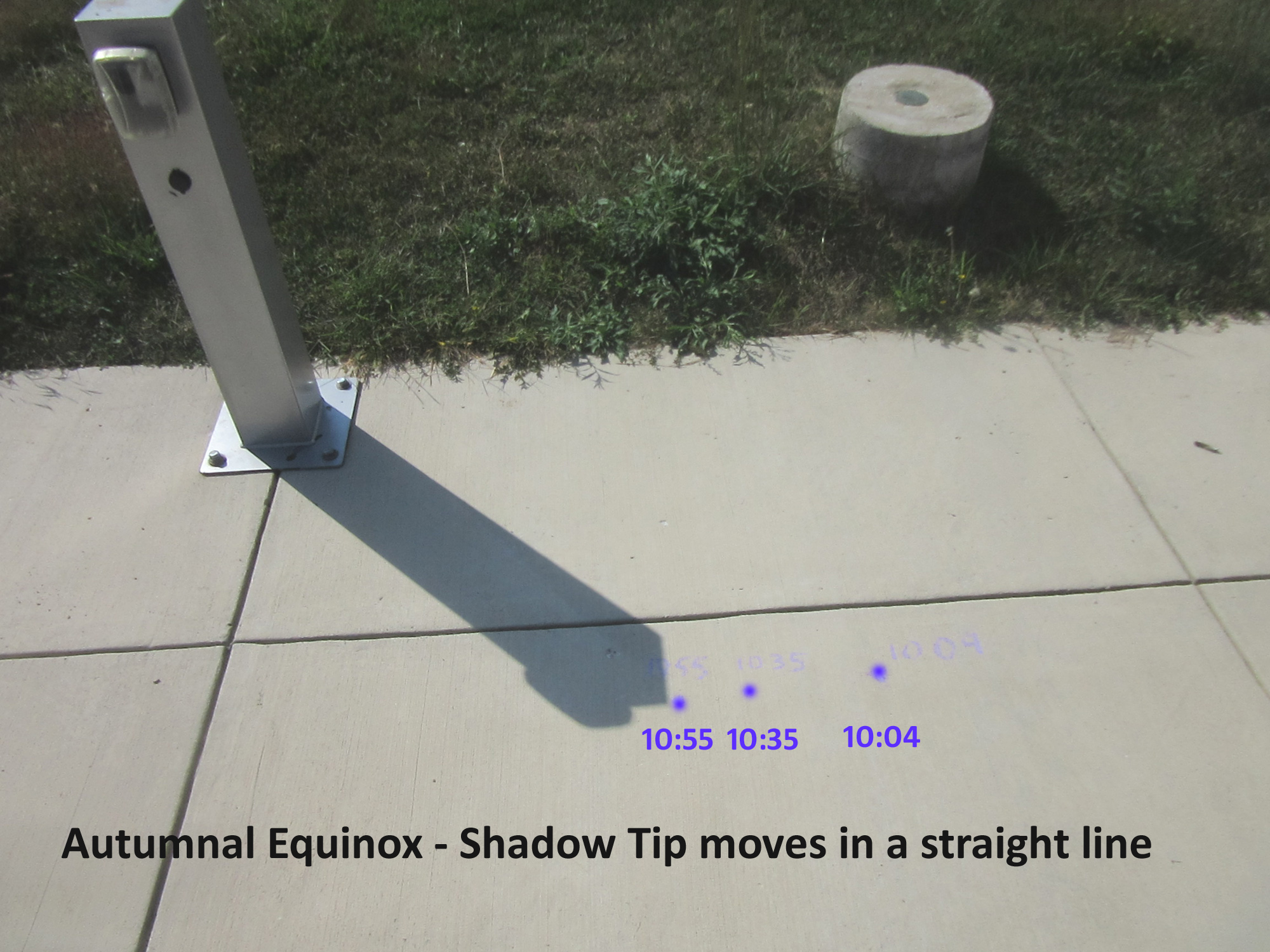 Last year during the fall equinox at Turner Farm we followed the tip of the shadow from our flagpole in the field adjacent to the Roll-Top and RATO observatories. Every half hour we put a stake in the ground where the shadow tip fell. Amazing...on the equinox the shadow follows a straight line from west to east. On other days of the year the shadow follows a bent (hyperbolic) path. You can see the stakes put into the ground at half hourly intervals form a line.
Last year during the fall equinox at Turner Farm we followed the tip of the shadow from our flagpole in the field adjacent to the Roll-Top and RATO observatories. Every half hour we put a stake in the ground where the shadow tip fell. Amazing...on the equinox the shadow follows a straight line from west to east. On other days of the year the shadow follows a bent (hyperbolic) path. You can see the stakes put into the ground at half hourly intervals form a line.
At the top of the flagpole is a small ball. You would think that it is easy to look for its shadow and mark the shadow tip on the ground. But a strange thing happens. It is very much like a partial solar eclipse (and remember NEVER look directly at the sun). In this case it is the ball on the flagpole blocking part of the sun. Because they appear as different sizes, sunlight "leaks" around the flagpole ball and the shadow on the ground is washed out and indistinct.  This is a penumbral shadow in technical parlance and makes the shadow hard to see. For our flagpole at a time near noon, the ball appears almost the size of the sun and the shadow is sharper and easier to see and mark with a stake.
This is a penumbral shadow in technical parlance and makes the shadow hard to see. For our flagpole at a time near noon, the ball appears almost the size of the sun and the shadow is sharper and easier to see and mark with a stake.
Now let’s go to a smaller scale, something that you can do in your backyard. We'll show you an example of what we did using the observatory's sidewalk where we have power piers that are just short of 3-feet high. On the equinox we marked the shadow tip with chalk at different times. The chalk is hard to see in the photo, so we enhanced it a bit with purple dots. The photo shows the morning shadow traveling west to east as the ten o'clock hour advances. The dots form a straight line.
 You can make the same observations using a stick in the ground and follow the tip of the shadow through the day, putting a pebble or a penny down at half-hour intervals. You too can then “draw a straight line” to show your equinox shadow’s travel.
You can make the same observations using a stick in the ground and follow the tip of the shadow through the day, putting a pebble or a penny down at half-hour intervals. You too can then “draw a straight line” to show your equinox shadow’s travel.
So why does the shadow move in a straight line? Imagine that you have a great big ball with its center at the top of your stick. This is the celestial sphere with its axis pointed to the north celestial pole. On the equinox the sun is on the celestial equator, sort of like a belt going around the middle of the sphere. During the day the sun travels from east to west on that belt as the whole celestial sphere turns. (Of course you and I know it is the earth turning, not the sun).
But that celestial equator when projected to the ground is seen on edge. That means that it doesn't look like a circle, it looks like a line...a straight line. And that's what happens to the stick's shadow. It follows that projection following a straight line.
At other times of the year the sun is either north or south of the celestial equator and no longer follows a "great circle" but appears to follow a small circle on the sphere. (The smallest circles...and you can see them on some globes of the earth ...are called the Tropic of Cancer and the Tropic of Capricorn for the sun's summer and winter solstices). Those circles when projected onto the ground form hyperbolas.
During the summer the hyberbola shadow line curves downward to the south, and during winter the path of the shadow will have a morning and evening end that points upward toward the north. Only on the spring and fall equinox does the sun's daily (diurnal) shadow travels in a straight west-east line. Try it yourself on the equinox occuring on Tuesday, September 22, 2020.

